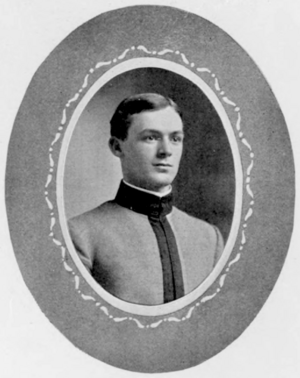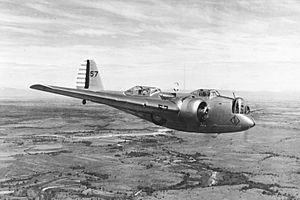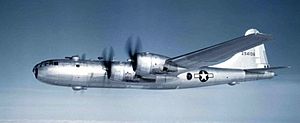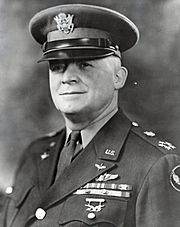Henry H. Arnold facts for kids
Quick facts for kids
General of the Army
General of the Air Force Henry H. Arnold
|
|
|---|---|
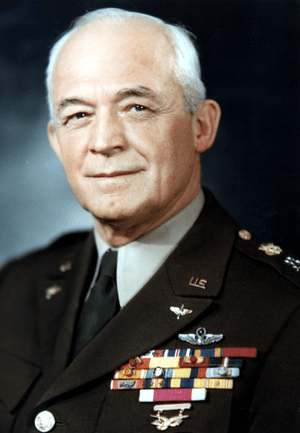
General Henry H. Arnold between 1946 and 1949
|
|
| Nickname(s) | "Hap", "Pewt", "Benny", "The Chief" |
| Born | June 25, 1886 Gladwyne, Pennsylvania, U.S. |
| Died | January 15, 1950 (aged 63) Sonoma, California, U.S. |
| Buried | |
| Allegiance | United States |
| Service/ |
|
| Years of service | 1907–1947 (Army) 1947–1950 (Air Force) |
| Rank | General of the Army General of the Air Force |
| Service number | O-2255 |
| Commands held | United States Army Air Forces Twentieth Air Force 1st Wing, GHQ Air Force |
| Battles/wars | World War I World War II |
| Awards | Army Distinguished Service Medal (3) Legion of Merit Distinguished Flying Cross Air Medal |
Henry Harley "Hap" Arnold (June 25, 1886 – January 15, 1950) was a top American military leader. He became a General of the Army and later a General of the Air Force. Arnold was a true pioneer in aviation. He led the Air Corps and then the United States Army Air Forces. He is the only U.S. Air Force general to reach five-star rank. He is also the only officer to hold a five-star rank in two different U.S. military branches.
Arnold learned to fly from the famous Wright brothers. He was one of the first military pilots in the world. He even overcame a fear of flying that came from his early experiences. He helped the Air Service grow a lot during World War I. He was also a close friend and student of General Billy Mitchell.
Just before the U.S. joined World War II, Arnold took command of the Army Air Forces. He oversaw its huge growth from about 20,000 people and 800 planes to the largest and most powerful air force ever. He strongly believed in new technology and research. Under his leadership, the military developed long-range bombers, jet fighters, and used radar widely. He also saw the rise of global airlift and atomic warfare as key parts of modern air power.
His most common nickname, "Hap," was short for "Happy." People started calling him this when he worked as a silent film stunt pilot in 1911. His family called him Harley when he was young, and his mother and wife called him "Sunny."
Contents
Early Life and Becoming a Pilot
Henry Arnold was born on June 25, 1886, in Gladwyne, Pennsylvania. His father was a doctor. Henry didn't plan to go to West Point, the military academy. He wanted to go to college and become a minister. But he took the entrance exam for his older brother. Henry did well and got a spot at West Point.
He entered West Point when he was 17. He was known for being a bit of a prankster. He played football and was good at polo. He wanted to join the Cavalry after graduating. But because of his grades and behavior, he became a second lieutenant in the Infantry in 1907. He was sent to the Philippines.
Arnold didn't like infantry duties. He volunteered to help map the island of Luzon. Later, he heard that the Signal Corps was looking for pilots. In 1909, he saw his first airplane flying in Paris, France. He decided he wanted to be a pilot.
Learning to Fly
On April 21, 1911, Arnold was sent to Dayton, Ohio. He went to the Wright brothers' flying school. He learned to fly from Arthur L. Welsh. On May 13, he flew solo for the first time. He earned his pilot certificate on July 6, 1911. He later received Military Aviator Certificate Number 2. This made him one of the first military pilots in U.S. history.
After training, Arnold became one of the Army's first flight instructors. He set altitude records several times. In August 1911, he had his first plane crash. In September, he became the first U.S. pilot to carry mail. He was also the first to fly over the U.S. Capitol. He even carried a U.S. Congressman as a passenger.
Early flying was very dangerous. Many pilots crashed. In 1912, Arnold had another crash. Two of his friends and classmates died in crashes. He started to feel very nervous about flying. He took a break from flying.
In December 1911, the flight school moved to Georgia. Training was difficult due to bad weather. They returned to Maryland in May 1912.
Arnold won the first Mackay Trophy in October 1912. This award was for the most outstanding military flight of the year. He found a cavalry company from the air and returned safely. He then worked on using radio communications from planes with the field artillery. On November 2, he sent the first radio message from an aircraft to the ground.
Marriage and Returning to Aviation
On December 1, 1912, Arnold took a staff job in Washington, D.C. He was promoted to first lieutenant in April 1913. But he was not happy. He wanted to go back to the Philippines.
On September 10, 1913, Henry married Eleanor "Bee" Pool. In January 1914, they moved to the Philippines. There, he became friends with George C. Marshall. Marshall later became a very important general. In January 1915, their first child, Lois Elizabeth, was born.
In 1916, Arnold returned to the U.S. He was encouraged by friends to fly again. He spent time flying a safer training plane. By December 1916, he felt comfortable flying solo again. He qualified for his Junior Military Aviator rating. This earned him a temporary promotion to captain.
In January 1917, Arnold was sent to Panama. He was to find a place for an airfield. While he was traveling back to the U.S., America declared war on Germany. Arnold wanted to go to France to fight. But he was needed in Washington, D.C. for headquarters duty.
He received several promotions quickly. On June 27, 1917, he became a major. On August 5, 1917, he became the youngest full colonel in the Army. He gained experience in building planes, setting up airfields, and training many new people. This experience was very important for his future leadership roles.
Arnold's third child, William Bruce, was born in July 1918. He finally went to France in November 1918. But the war ended on the same day he arrived.
Between the World Wars
Supporting Airpower
After World War I, the Air Service became separate from the Signal Corps. But it was still controlled by the Army. Many Army leaders believed that air power was just a small part of the Army.
Arnold supported Billy Mitchell, who wanted a completely independent air force. Mitchell believed that air power should be its own branch of the military. Arnold's support for Mitchell caused problems for his career. Mitchell was later put on trial by the Army. Arnold and other supporters testified for him.
After Mitchell was found guilty, Arnold was sent to a remote base in Kansas in 1926. This was a punishment for supporting Mitchell. He was told he could resign or face a court-martial. Arnold chose to stay in the service. He even turned down an offer to become president of Pan American World Airways, which he had helped start.
Despite this setback, Arnold worked hard. He impressed other generals with his skills. In 1928, he wrote six children's books about flying. These books were called the "Bill Bruce Series." They were meant to get young people interested in aviation.
Leading the Air Corps
In 1928, Arnold was assigned to the Command and General Staff School. He graduated with high marks in 1929. In 1931, he was promoted to lieutenant colonel.
Arnold took command of March Field in California in 1931. He worked to improve the base and build good relationships with the local community. His units helped with disaster relief, like during the 1933 Long Beach earthquake. He also started acquiring land that would later become Edwards Air Force Base, a famous test site.
In 1934, Arnold led ten Martin B-10B bombers on a long flight to Alaska and back. This was a huge achievement for its time. He won his second Mackay Trophy for this flight.
In 1935, Arnold was promoted to brigadier general. He became the Assistant Chief of the Air Corps. His job was to handle buying and supplying aircraft.
In September 1938, the Chief of Air Corps, Major General Oscar Westover, died in a plane crash. Arnold was the natural choice to replace him. Some people tried to stop his appointment, but President Franklin D. Roosevelt appointed Arnold as Chief of Air Corps on September 29. This promotion made him a major general.
Arnold strongly supported research and development in aviation. He pushed for projects like the B-17 bomber and jet propulsion. He believed in getting enough planes quickly, even if it meant sacrificing some perfect quality. He also worked with Theodore von Kármán to create the Scientific Advisory Group. This group brought civilian experts to help with military aviation.
Arnold also worked with Ira C. Eaker to write books promoting air power. These included This Flying Game (1936) and Winged Warfare (1941).
World War II Leadership
Building the Air Forces
The U.S. Army Air Forces (AAF) was created on June 20, 1941. Arnold became its Chief. This gave the air arm its own staff and brought all air organizations under one commander. However, it was not yet a fully separate military branch. The decision to make the Air Force independent was put off until after the war.
In July 1941, President Roosevelt asked for plans to defeat potential enemies. Arnold's team created a plan called AWPD/1. This plan outlined four main goals for the AAF: defending the U.S., a defensive strategy against Japan, a strategic air attack against Germany, and later, a strategic air attack against Japan. It also called for the AAF to grow to 60,000 aircraft and 2.1 million people.
Soon after the U.S. entered the war, Arnold was promoted to lieutenant general on December 15, 1941. In March 1942, the War Department gave the AAF full independence. It was now equal to the Army Ground Forces and Services of Supply. Arnold became the AAF Commanding General. He also joined the Joint Chiefs of Staff, a group of top military leaders.
Arnold also approved the creation of the Women's Flying Training Detachment (WFTD) in 1942. This program allowed women pilots, led by Jacqueline Cochran, to fly military aircraft.
Strategic Bombing in Europe
Arnold quickly put his plans into action after the attack on Pearl Harbor. The main bombing force against Nazi Germany was the Eighth Air Force. He chose his friends Carl Spaatz to command it and Ira C. Eaker to lead its Bomber Command.
Early in the war, the U.S. strategy was to bomb targets in daylight. But the bombers faced heavy losses from German fighters. Eaker asked for more fighters and extra fuel tanks to protect the bombers. Arnold was under pressure to get results. He blamed the bomber commanders for not being aggressive enough.
General Dwight D. Eisenhower was preparing for the invasion of Europe. Arnold approved Eisenhower's request to replace Eaker with Spaatz and James H. Doolittle. Luckily, the new commanders received the very things Eaker had asked for: more bombers, drop tanks, and P-51 fighters. These changes helped the Eighth Air Force succeed in defeating Germany.
B-29 Operations Against Japan
After the bombing campaign in Europe improved, Arnold focused on the B-29 bomber. This very long-range bomber was needed to attack Japan. Arnold decided to command the Twentieth Air Force himself. This was a unique arrangement. He wanted to make sure the B-29 operations were handled correctly.
The B-29 program had many problems during its development. This led to criticism for Arnold. The B-29 was crucial because no other land-based bomber could reach Japan. Arnold needed the B-29 to deliver the highly secret atomic bomb if the Manhattan Project succeeded.
B-29 operations against Japan began in June 1944. They started from bases in China and Southeast Asia. The early results were not as good as expected. Arnold quickly replaced commanders who weren't getting the results he wanted. In January 1945, he replaced General Haywood S. Hansell with Curtis E. LeMay. LeMay then led the B-29 campaign from the Mariana Islands.
Later Years and Legacy
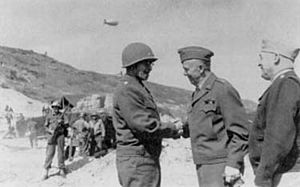
Health Challenges
Between 1943 and 1945, Arnold had four heart attacks. He traveled a lot during the war, which caused him great stress. This made his heart problems worse.
His first heart attack was on February 28, 1943. He was hospitalized for several days. U.S. Army rules said he should leave the service. But President Roosevelt allowed him to stay. He just had to send monthly updates on his health.
He had another heart attack in May 1943. His third was in May 1944, due to the stress of the B-29 problems. His last wartime heart attack was on January 17, 1945. He was again allowed to stay in service but with lighter duties.
Promotion and Retirement
On March 19, 1943, Arnold was promoted to full general. On December 21, 1944, he became a five-star General of the Army. He was one of only five men to hold this rank. This rank was created to give American commanders the same high rank as their British allies.
In 1945, Arnold helped create Project RAND. This became the RAND Corporation, a non-profit research group. It was meant to connect military planning with research and development.
Arnold left active duty on February 28, 1946. He retired to a ranch in Sonoma, California. He wrote his memoirs, Global Mission, to help his family financially. He suffered his fifth heart attack in January 1948 while writing the book.
On May 7, 1949, his rank was changed to General of the Air Force. He is the only person to have held this rank. He is also the only person to hold five-star rank in two different U.S. military services.
Death
Henry "Hap" Arnold died on January 15, 1950, at his home. He had a state funeral in Washington, D.C. He was buried in Arlington National Cemetery. Many people said he was a casualty of war because of the stress he endured.
All three of Arnold's surviving sons also graduated from West Point. They all became colonels. Two of his sons served in the Air Force and are buried near him.
Legacy
Many places and awards are named after General H. H. Arnold:
- The athletic fields at Lower Merion High School in Pennsylvania.
- Arnold Air Force Base in Tennessee.
- Arnold Hall, the cadet social center at the United States Air Force Academy.
- The Civil Air Patrol has an award called the Hap Arnold Award.
- The Air Force Association gives out the H. H. Arnold Award for contributions to national defense.
- The Arnold Air Society, an honorary organization in Air Force ROTC, is named for him.
- The Air Force Aid Society, which he founded, gives college scholarships in his name.
In 1967, "Hap" Arnold was added to the National Aviation Hall of Fame. In 1972, he was inducted into the International Air & Space Hall of Fame.
In 2011, during the last mission of the Space Shuttle Endeavour, a five-star insignia of Arnold's was carried into space. This was a tribute to his important legacy.
The high school at the former Wiesbaden Air Base in Germany was named General H. H. Arnold High School in 1949.
On November 7, 1988, the United States Postal Service released a postage stamp honoring H. H. "Hap" Arnold.
Images for kids
-
The court-martial of Billy Mitchell, November 1925
-
Maj. Gen. Mason Patrick, Chief of Air Service
See also
 In Spanish: Hap Arnold para niños
In Spanish: Hap Arnold para niños


